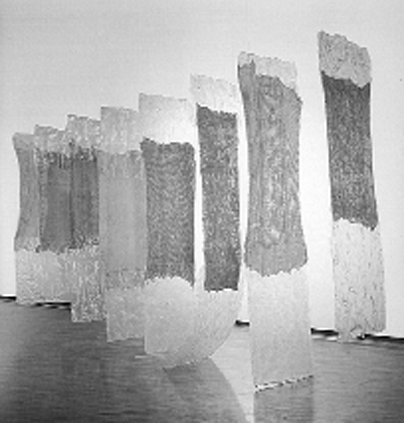By Lorne Colón
It feels like every season in New York a different artist is honored with several concurrent exhibitions, bestowing upon them “legendary” status in the history of art. The pattern of who is chosen can be hard to follow, and recently more living than deceased artists have been crowned as royalty in NYC. This Summer however, the late Eva Hesse has been chosen as the queen of all things contemporary. Hesse was born in Germany in 1936, and was brought to the United States by her family shortly after the war became unbearable. Settling in New York City in her twenties, Hesse quickly became a figurehead of the New York art scene, growing into one of the most influential artists of the century before dying of cancer at the age of 34. Two current exhibitions, one at the Drawing Center in Soho and the other at the Jewish Museum examine distinct bodies of her oeuvre. In addition, Yale University Press has published two significant catalogs to accompany the shows, adding to the already legendary status of Eva Hesse.
The exhibition at the Jewish Museum focuses on Hesse’s claim to fame, her sculpture. The show reunites the majority of works from her landmark, and only solo sculpture exhibition entitled “Chain Polymers” from 1968. In addition, numerous significant pieces from group shows and her last unfinished works round out the show. The “Chain Polymers” work highlights the fact that Hesse was breaking ground faster than most, and would have continued pushing art’s boundaries had she not been stopped by the very materials she coveted. It has long been suspected that the latex, fiberglass, resin she used brought on her cancer and ultimate death in 1970. The journals and notes that also accompany this show only hint at the directions she may have followed.
The show at the Drawing Center, focusing primarily on Hesse’s 2D work, feels like a micro-history of late 20th century fine art. Her drawings, over the course of the decade before she passed away, ran the gamut from expressive color to the ultra minimal. Stand-alone drawings here are few and far between, since the show is filled mostly with Hesse’s preparatory sketches, mockups, and notes. Although simple, these works show a mind that was far ahead of her time, resembling both works by her peers and others who would rise to prominence long after her death. Later drawings bring to mind Agnes Martin’s adherence to the grid, with both artists using graphite for their deceptively simple squares. Meanwhile, the early color works seem to forecast the psychedelic patterns of Franz Ackerman by almost three decades. Although the show is focused on drawings, a handful of small sculptures, a relief, and test works show the purpose behind the process laid bare on the walls. Seeing Hesse’s journal pages and quick sketches shows an obsession with simplified form, and a desire to push her non-traditional media as far as she could.
As documents of these important exhibitions, and as additions to any art library, the two catalogs published by Yale University Press are wonderful in and of themselves. The sculpture catalog provides beautiful reproductions of work that will probably not exist in time, due to the decay of the materials that make them up. The drawing catalog provides those interested with a deep understanding of Hesse’s complete growth as an artist, reproducing both the drawings and the smaller sculptures in the show. The majority of the works present in this book were previously unavailable, and provide an indispensable look at Hesse’s creative process. In addition, both books contain archival materials such as personal journals, an early profile from Seventeen magazine, and other ephemera. The sculpture catalog documents a book Hesse’s father made for her about fleeing Germany and details her years growing up as a child, as well as numerous pictures from throughout her life. These two catalogs add immeasurably to a picture of Hesse as a pillar of contemporary art. Although a Catalog Raisonne is just around the corner, these two volumes and the exhibitions provide an interesting behind the scenes look at this immeasurably important artist.
The Drawing Center exhibition is open through July 15, and the Jewish Museum show runs through September 17. Both catalogs are available at their respective shows, and through Yale University Press.
WWW Downtown Express

























